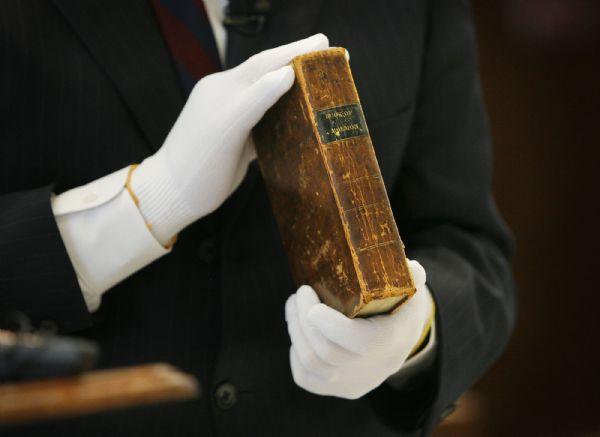This is an archived article that was published on sltrib.com in 2009, and information in the article may be outdated. It is provided only for personal research purposes and may not be reprinted.
The LDS Church unveiled its state-of-the-art Church History Library in downtown Salt Lake City on Thursday, showing off its climate-controlled storage units, computerized conservation techniques and priceless artifacts.
Marlin Jensen, LDS Church Historian and member of the church's First Quorum of Seventy, wore white gloves as he showcased a handful of historic items. They included an 1835 LDS hymnal, a scrapbook of the late church president, Ezra Taft Benson's post-World War II humanitarian efforts in Europe, a new Spanish translation of the King James version of the Bible, and a one-of-a kind 1852 Book of Mormon, translated into French on one side of the page and German on the other.
"There is great value in what we save and store here," Jensen said. "It is helping us remember what the church was, is and will be."
For Mormons, preserving history is a sacred mandate and this new building suggests the church's willingness to be open about its past "is in a period of expansion," Jensen said.
Members of The Church of Jesus Christ of Latter-day Saints have been keeping records since the church's beginnings in upstate New York in 1830, when, they believe, God told founder Joseph Smith "there shall be a record kept among you ... for the good of the church ... and the rising generations."
Since then, Mormons in every era and nation have recorded their experiences in journals, letters, business agreements, minutes of church meetings and photos. The massive collection includes 600,000 photos alone, as well as 270,000 books, pamphlets, magazines and newspapers, 240,000 collections of original, unpublished records, journals, diaries, correspondence and minutes. There are 23,000 audio-visual items, 4,000 oral histories and millions of digitized pages. Until now, the collection was housed in the east wing of the 26-story Church Office Building on North Temple.
It took just 19 days to physically move the collection to the new building at 15 East North Temple, but it took hundreds of volunteers a year and a half to tag and categorize each piece slated for the move.
The new building features 12 preservation vaults, protected by high security. Of those, 10 are maintained at 55 degree Fahrenheit, with 35 percent humidity and two are kept at minus 4 degrees Farenheit for extra sensitivity.
"For every 18 degrees down you go, the document has a longer life," said Steven L. Olsen, managing director of Church History Department.
There is also a conservation lab, with a darkroom where conservators turn acetate negatives into useable photographs, and a document cleaning room where they clean historical records and apply age-slowing chemical treatments.
Every year, about 6,000 new items are donated to the church, including an annual history of every LDS congregation in the world.
Since master forger Mark Hofmann deceived church officials in the 1980s, officials have had policies designed to protect itself.
Hofmann arrived on the scene during the halcyon days of Leonard Arrington, the church's first professional historian who gave researchers unfettered access to the church's primary source materials, some of which had never been seen before. Arrington influenced a whole generation of Mormon historians and his team produced scores of credible, thoughtful scholarship.
Hofmann created a number of documents that seemed to undermine the church's official history. After his deception was exposed, LDS officials became much more guarded about access to the church's holdings and much more wary of new interpretations of those founding events.
Hofmann, who killed two people in an attempt to cover up his fraud, remains in the Utah State Prison.
Some of Hofmann's documents still reside in the archives, but any new document must be examined carefully to prove where it came from, whether its hand-writing, paper and ink are of the appropriate age and whether its contents fit with what is already well-established about the events it describes.
Today, Olsen said, church archivists are much better at discovering bogus documents "than we used to be."
The library limits access to documents it deems "sacred," (referring to temple rituals), "private," (legal or medical information) and "confidential," (referring to personal confessions, callings or ways the church ran its business), but most of the journals of LDS apostles and other leaders are completely open, Jensen said. "If people want access, it is almost always available."
Also, the library puts no restrictions on which researchers can use its documents.
"People might use the materials to criticize the church, but that's the risk we have to take," Jensen said. "We have a history and a people and things that all of us regret, but we don't have anything to hide."
pstack@sltrib.com" Target="_BLANK">pstack@sltrib.com
If you go:
A public open house of the LDS Church History Library will be held Friday and Saturday from 9:00 a.m. to 8:00 p.m. Tickets are not required.
LDS officials will dedicate the library on Saturday, June 20. Overflow seating will be available in the Conference Center Theater. The dedication will also be broadcast on BYU TV.
The library will open permanently on Monday, June 22.



